Exploring nature’s beauty becomes even more exciting in 2025, with updated trail conditions and new permit systems making journeys smoother. From coastal paths to alpine summits, diverse terrains await adventurers seeking breathtaking views and thrilling challenges.
This guide highlights routes chosen for popularity, scenic value, and unique 2025 considerations. Research covered over 2,000 miles of trails, ensuring only the best make the list. Whether tackling rugged coastlines or winding through redwood forests, each path offers something special.
Later sections will cover essential gear and safety tips, so you’re fully prepared. For now, let’s dive into what makes these trails stand out.
Table of Contents
Key Takeaways
- 2025 brings updated trail conditions and permit requirements
- Routes span diverse landscapes, from deserts to mountains
- Selections based on popularity, scenery, and current trail data
- Over 2,000 miles researched for accuracy
- Gear and safety tips covered in later sections
Why These Hiking Trails Stand Out in 2025
Adventure seekers will find diverse landscapes and fresh challenges across America’s national parks this year. From misty coastal paths to rugged alpine climbs, each trail offers something special. Updated permits and timed entry systems make exploring smoother than ever.
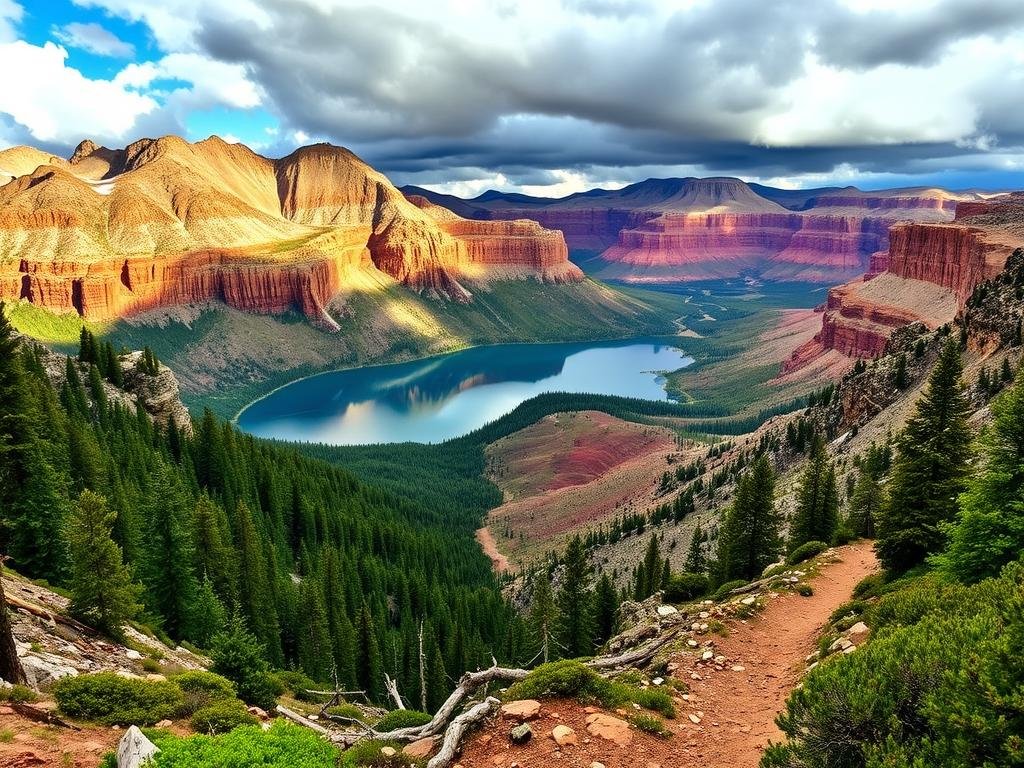
Diverse Landscapes and Unique Challenges
Zion’s Angels Landing features steep chains and river wading in The Narrows—a thrilling test of skill. Meanwhile, Glacier National Park’s Highline Trail reveals alpine meadows shifting due to climate change.
Grand Canyon’s layered rock formations showcase millions of years of geologic history. For those seeking solitude, Yosemite’s Taft Point delivers epic views without the crowds.
Accessibility and Popularity Among Hikers
Great Smoky Mountains’ Alum Cave Trail welcomes families, while Half Dome’s cables challenge experts. Zion’s new timed entry system helps manage crowds at popular spots like The Narrows.
With 423 national parks to explore, the America the Beautiful Pass offers great value for frequent hikers. Many parks now require advance reservations for iconic trails like Glacier’s Highline.
Elevation changes and varied terrain mean there’s something for every skill level. From day hikes to multi-day adventures, 2025 brings exciting opportunities to explore.
Yosemite National Park: A Hiker’s Dream
Granite cliffs and waterfalls define Yosemite’s legendary hiking experiences. This national park offers routes ranging from short waterfall walks to multi-week wilderness treks. For 2025, updated permit systems and trail conditions make exploring easier than ever.
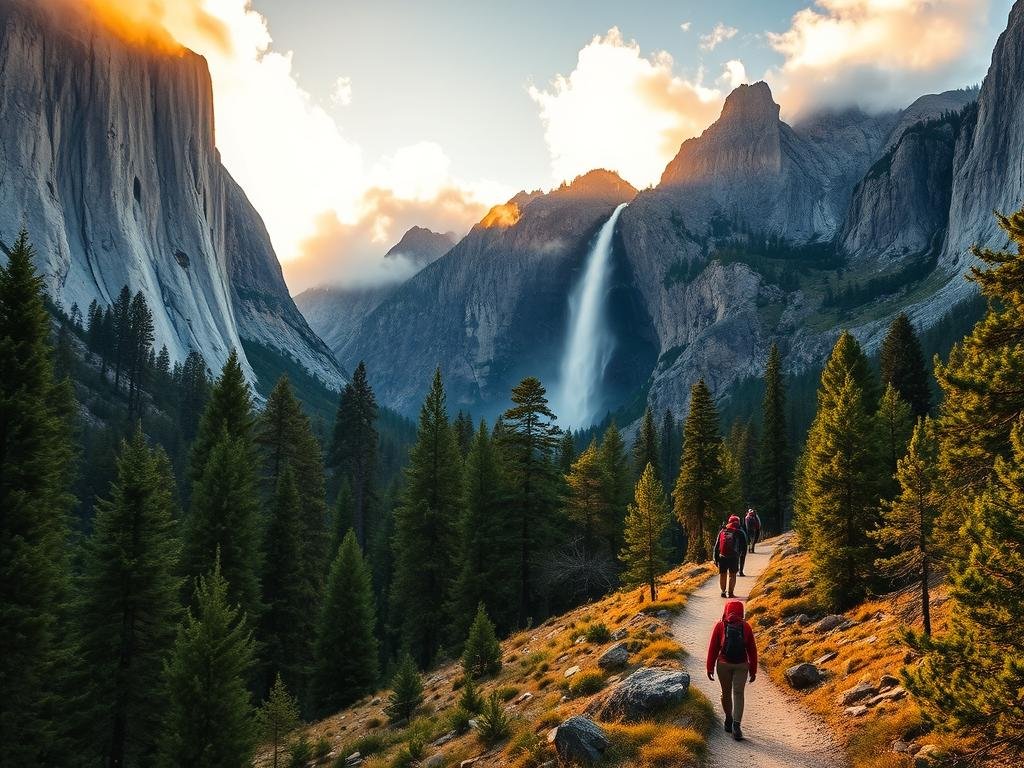
Iconic Paths Worth Every Step
The Mist Trail challenges hikers with 1,000 feet of elevation gain via steep granite steps to Vernal Fall. This 5.4-mile round trip rewards effort with cooling spray and thunderous waterfall views.
Serious adventurers tackle the 211-mile John Muir Trail connecting Yosemite to Kings Canyon National Park. Most complete this epic route in 2-3 weeks, passing through alpine lakes and meadows.
Seasonal Considerations and Difficulty
Tuolumne Meadows explodes with color during peak wildflower season from late June to early July. Summer offers the most accessible conditions, while winter brings ice axe requirements for Cathedral Peak.
The famous Half Dome hike now requires permits secured through a lottery system. This 14-mile journey gains 5,300 feet, testing endurance with its final cable-assisted climb.
For those seeking spectacular views with fewer crowds, the 12-mile Pohono Trail delivers. Its 3,700-foot elevation gain and route-finding challenges make it best for experienced hikers.
Proper preparation makes all the difference when exploring Yosemite’s trails. Check current conditions and pack accordingly for a safe, memorable adventure.
Zion National Park: Desert Oasis Adventures
Towering sandstone cliffs meet rushing rivers in this Utah national park. Zion offers both heart-pounding adventures and gentle family walks across its striking desert terrain. The contrast between watery slot canyons and arid plateaus makes every trail unique.
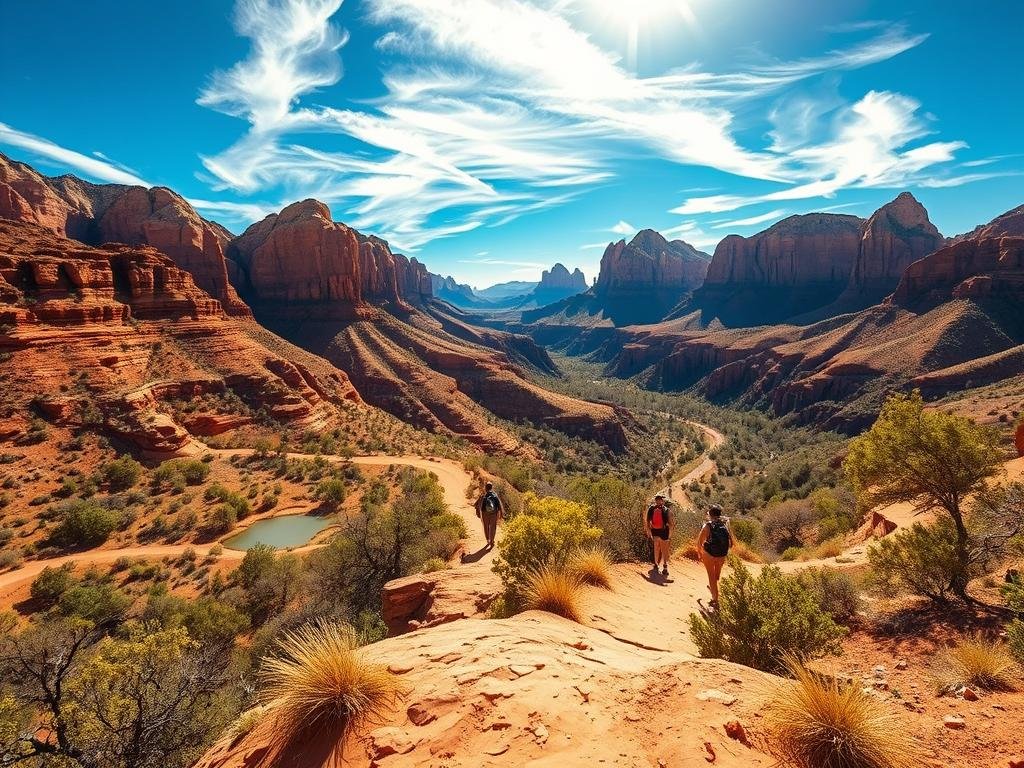
Angels Landing and The Narrows Highlights
Angels Landing demands focus with its 1,488-foot drop-offs and chain-assisted climbs. The park completed chain maintenance in early 2025 for safer ascents. This 5-mile round trip gains 1,500 feet, rewarding hikers with panoramic views.
The Narrows requires different preparation. Summer hikers need sturdy water shoes, while winter visits demand drysuits for the Virgin River wading. Rangers now mandate 160-lumen headlamps due to flash flood risks in narrow canyon sections.
Family-Friendly vs. Challenging Routes
New twilight hikes to Emerald Pools offer ranger-led evening explorations of desert water sources. The 0.4-mile Weeping Rock Trail suits all ages with its short, shaded path.
For serious backpackers, the 16-mile West Rim Trail crosses multiple elevation zones. It showcases Zion’s diversity beyond crowded hotspots. Pack plenty of water—desert conditions demand extra hydration.
Whether seeking adrenaline or relaxation, this national park delivers unforgettable experiences. Proper gear and respect for the terrain ensure safe adventures.
Great Smoky Mountains: Misty Peaks and Wildlife
Morning fog wraps around ancient peaks in America’s most visited national park. With over 850 miles of trails winding through 522,427 acres, this UNESCO site offers endless exploration. The landscape changes dramatically from valley wildflowers to spruce-fir forests near the summit.

Alum Cave and Clingmans Dome Trails
The 5.5-mile Alum Cave Trail delivers stunning geology. Hikers pass under Arch Rock’s natural tunnel before reaching an 80-foot waterfall. Steep sections gain 1,125 feet, rewarding effort with panoramic views.
Clingmans Dome provides options for all abilities. An ADA-accessible ramp leads to the observation deck, while backcountry routes challenge experienced trekkers. At 6,643 feet, it’s the highest point on the Appalachian Trail in the national park.
Wildlife Encounters and Seasonal Tips
Over 1,500 black bears roam these mountains—always store food in bear-proof containers. June brings magical synchronous firefly displays in Elkmont, with peak viewing June 3-10, 2025.
Spring wildflowers bloom April-May, while fall colors peak mid-October. Rangers recommend starting early to avoid afternoon storms on high ridges. The Rainbow Falls Trail showcases why this landscape inspired Jurassic Park comparisons.
Whether seeking a quick day hike or multi-day backpacking trip, these misty peaks deliver unforgettable adventures. Proper preparation ensures safe wildlife viewing and trail navigation.
Rocky Mountain National Park: Alpine Wonders
Glacial valleys and craggy summits create dramatic backdrops for hikers exploring Colorado’s high country. This national park offers everything from gentle lakeside strolls to extreme summit attempts, all above 8,000 feet elevation. Updated 2025 safety protocols make adventures safer while preserving the wild experience.
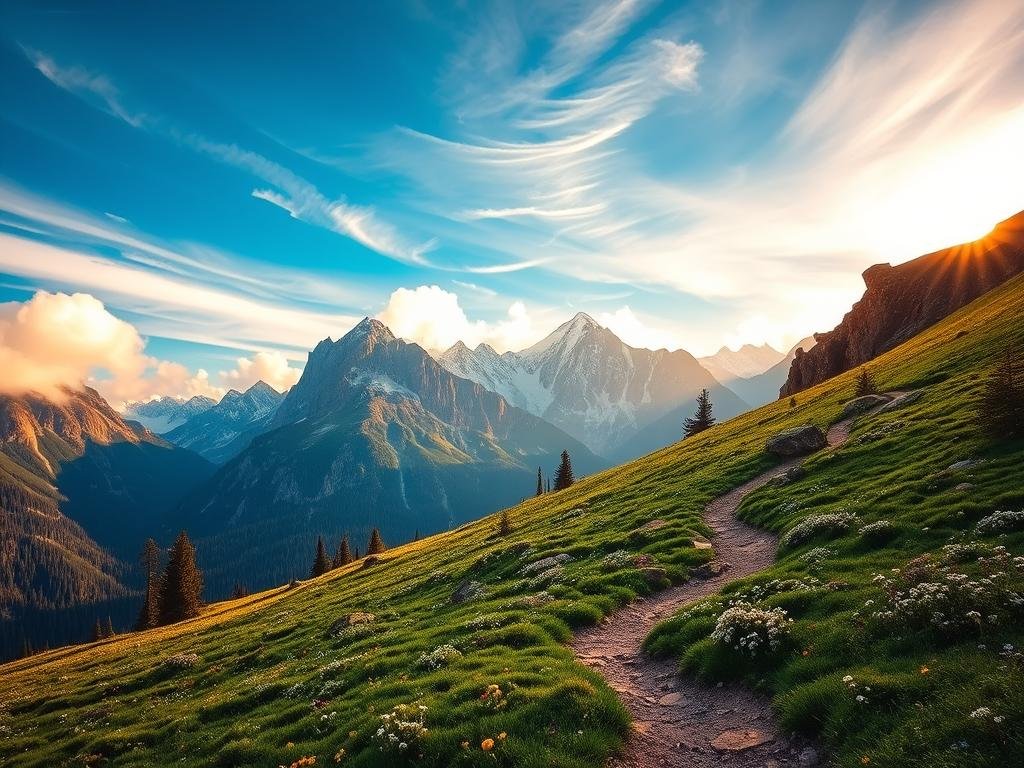
Contrasting Trail Experiences
Longs Peak challenges even seasoned hikers with its 5,000-foot elevation gain across 15 grueling miles. The park reports a 50% failure rate for summit attempts, often due to altitude effects. Summer permits now include mandatory weather briefings at the trailhead.
For accessible beauty, Bear Lake’s 0.6-mile loop accommodates wheelchairs with alpine views. Adventurers can extend to Sky Pond’s 9-mile trek past waterfalls and glacial basins. Trail Ridge Road connects these experiences as North America’s highest paved route.
High-Altitude Preparation
New ranger checkpoints monitor hikers for altitude sickness symptoms. Recommended precautions include:
- Acclimatize 2-3 days before attempting 14ers
- Use electrolyte mixes to combat dehydration
- Train with weighted packs and stair climbers
Colorado Mountain School updated guidelines for 14,000-foot peaks. They emphasize gradual ascent rates and recognizing early warning signs. The dry climate demands drinking twice as much water as lower elevations.
Whether seeking panoramic summits or serene alpine lakes, this park delivers unforgettable high-country experiences. Proper preparation transforms thin air challenges into rewarding achievements.
Grand Canyon National Park: Rim-to-Rim Beauty
Arizona’s iconic national park offers some of America’s most dramatic elevation changes across its trail system. From the south rim viewpoints to the Colorado River, hikers experience 1.8 billion years of exposed geology.
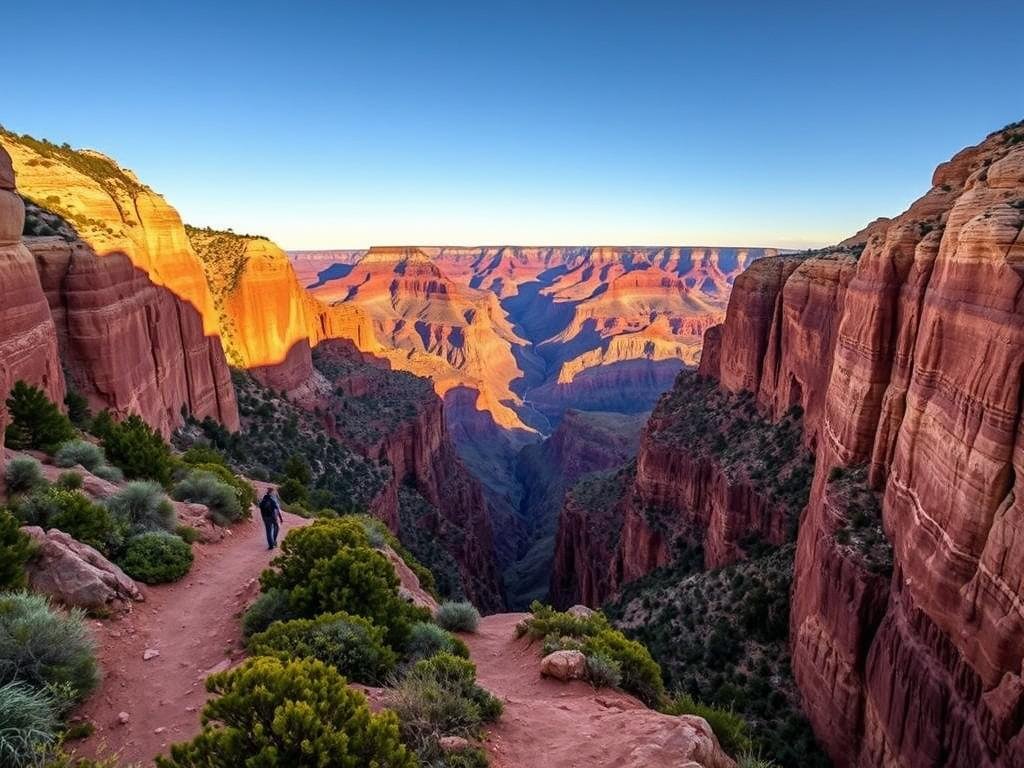
Choosing Your Canyon Descent
The South Kaibab Trail drops 4,780 feet over 7 steep miles with no water sources—ideal for experienced hikers moving quickly downhill. In contrast, Bright Angel Trail’s gentler 9.3-mile route features four seasonal water stations, making it safer for ascending.
Summer temperatures vary wildly—110°F at the canyon floor versus 40°F on the south rim. Rangers recommend hiking before 10am or after 4pm to avoid heat risks.
Extended Adventures Below the Rim
Securing Phantom Ranch requires planning—the 2025 lottery opens 15 months before desired dates. New Colorado River permits combine rafting with hiking, allowing multi-day itineraries along the Tonto Trail’s 70-mile network.
Essential gear for overnight trips includes:
- Heavy metal water filters for silt-filled tributaries
- Layered clothing for 70°F daily swings
- Headlamps with 160+ lumens for narrow canyon sections
Many hikers report the rim-to-rim journey sparks life-changing perspectives, often inspiring van life transitions or career shifts. Whether tackling a day hike or week-long expedition, the grand canyon delivers unmatched challenges and rewards.
Acadia National Park: Coastal Hikes with Ocean Views
Maine’s rugged coastline meets pristine forests in this breathtaking national park. Acadia offers diverse hiking experiences, from sunrise summits to cliffside adventures. The contrast between granite peaks and crashing waves creates unforgettable views.
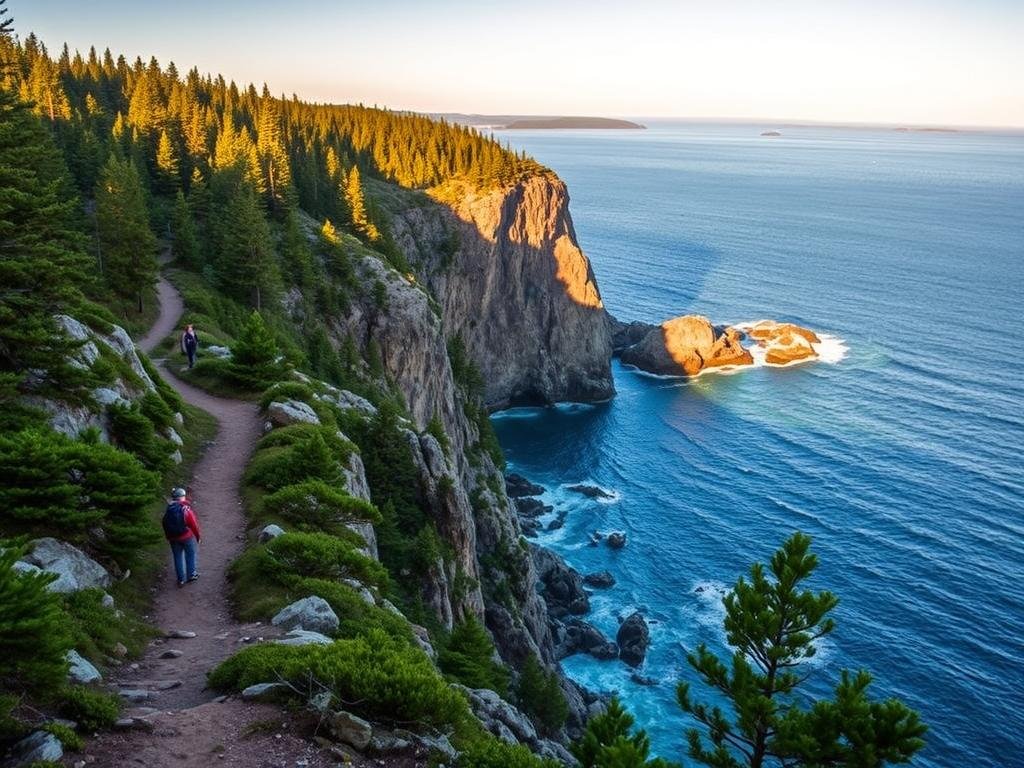
Cadillac Mountain Sunrise Experience
Watching dawn break from Cadillac Mountain’s summit is a bucket-list moment. The park requires sunrise reservations from mid-May through mid-October. Thirty percent of permits release 90 days early, while seventy percent become available two days prior at 10 a.m..
This highest point in Acadia delivers panoramic ocean and mountain views. Arrive early to secure parking—the summit road fills quickly. Morning temperatures often dip below 50°F, even in summer.
Precipice Trail Thrills and Safety
Precipice Trail challenges hikers with 1,000 feet of elevation gain in under a mile. Iron rungs and exposed ledges make this route one of Acadia’s most thrilling. The park closes sections seasonally to protect nesting peregrine falcons.
For gentler options, Ocean Path winds 2.2 flat miles along dramatic cliffs. New gear rental stations at Hulls Cove provide e-bikes and hiking equipment through L.L.Bean sponsorships.
Fall transforms the landscape with vibrant foliage. Dorr Mountain typically peaks around mid-October, though conditions vary yearly. Rangers recommend checking foliage trackers for optimal viewing times.
Whether seeking adrenaline or serenity, Acadia’s trails deliver. The coastal scenery rivals Europe’s famous Amalfi Coast routes. Proper preparation ensures safe enjoyment of these iconic paths.
Mount Rainier National Park: Glaciers and Wildflowers
Snow-capped peaks meet vibrant meadows in this Washington wonderland. With 260 miles of trails winding around a 14,410-foot active volcano, the park offers diverse adventures. From glacier treks to wildflower strolls, every season brings new experiences.
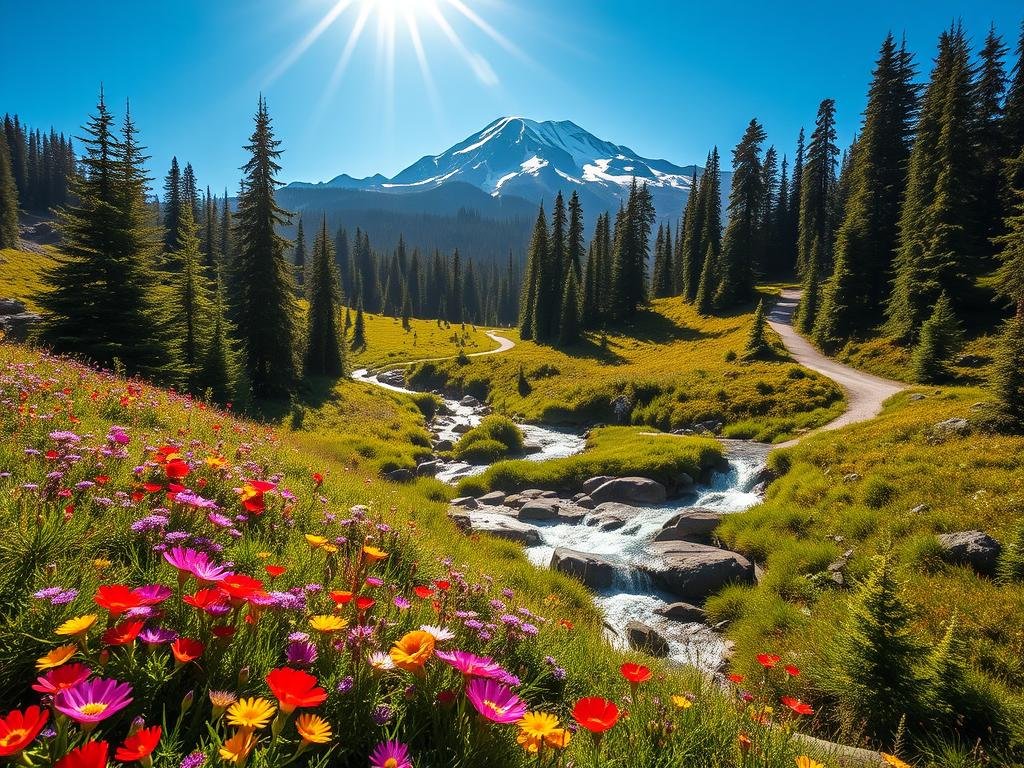
Skyline Trail and Waterfall Wonders
The Skyline Trail delivers breathtaking views on its 5.5-mile loop. Hikers gain 1,700 feet past Myrtle Falls’ 72-foot cascade, with Mount Rainier’s reflection shimmering in alpine lakes. Wildflower enthusiasts will spot over 700 species blooming mid-July through August.
For waterfall lovers, Comet Falls drops 300 feet over volcanic rock. This 3-mile hike gains 1,300 feet through old-growth forests. Sturdy boots are essential—the trail crosses multiple streams.
Four-Season Adventure Options
Winter transforms the landscape into a snowy paradise. The Naches Peak Loop remains accessible year-round, with new avalanche monitoring systems improving safety. Guided glacier treks run June-September through Northwest Alpine Guides.
Seasonal highlights include:
- July’s wildflower explosion in Paradise meadows
- September huckleberry harvests along the Wonderland Trail
- Winter snowshoe tours with ranger-led programs
Carbon Glacier offers unique views as North America’s lowest-elevation glacier. The Emmons Moraine Trail showcases its icy grandeur. Check volcanic activity reports before visiting—ash precautions mirror those at Mauna Loa.
Whether seeking alpine meadows or icy peaks, this park delivers unforgettable experiences. Proper preparation ensures safe enjoyment of its dramatic landscapes.
Glacier National Park: The Crown of the Continent
Alpine lakes shimmer beneath towering peaks in Montana’s wilderness wonderland. This national park spans over 700 miles of trails through diverse terrain, from flower-filled meadows to ancient glaciers. Updated 2025 shuttle services along Going-to-the-Sun Road make exploration easier than ever.
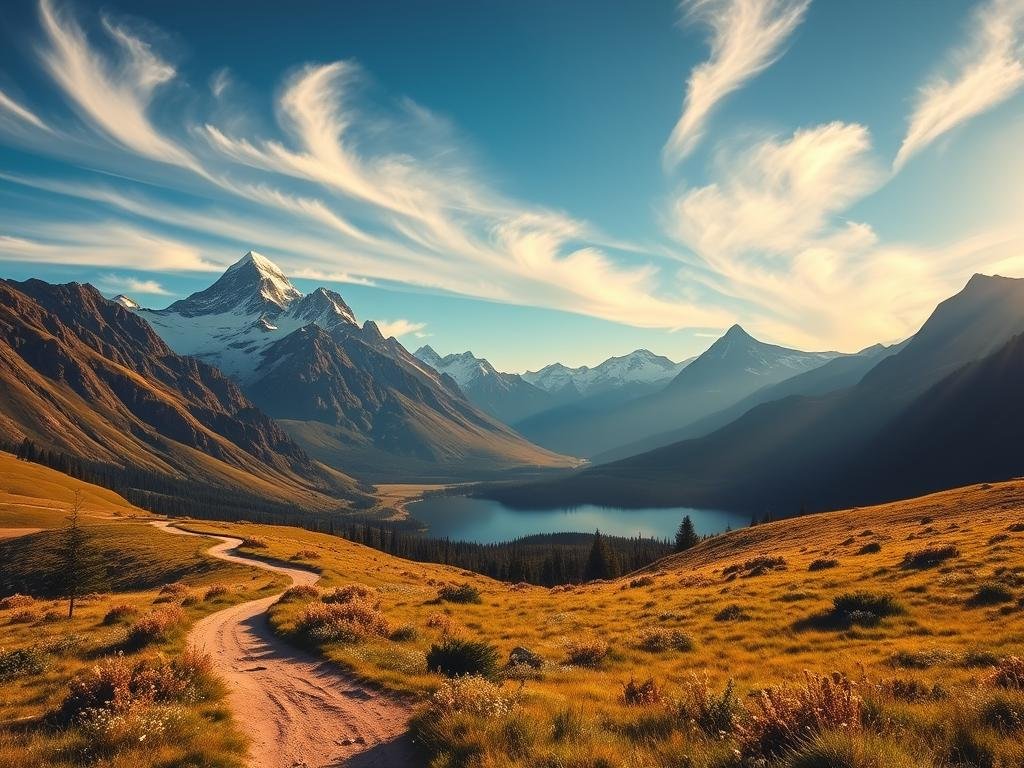
Grinnell Glacier Trail and Wildlife Spotting
The Grinnell Glacier Trail delivers breathtaking views across its 11-mile round trip. Hikers can shorten the journey by taking morning boats across Swiftcurrent and Josephine Lakes. Along the route, watch for mountain goats grazing on cliffs and grizzlies foraging in berry patches.
New bear spray rental stations at Many Glacier Hotel provide essential safety gear. Rangers recommend making noise when hiking through dense vegetation to avoid surprising wildlife. The park’s healthy populations of moose and bighorn sheep offer frequent sightings during summer months.
Best Seasons for Hiking and Camping
July transforms the park into a colorful wonderland with blooming bear grass and lupines. By September, golden larch trees create striking contrasts against evergreen forests. While summer offers warm temperatures, fall brings cooler air and thinner crowds to the trails.
Scientists warn that the park’s namesake glaciers are disappearing rapidly. Grinnell Glacier has retreated over 40% since 1966, adding urgency to visit these icy landmarks. Whether seeking wildflower meadows or autumn colors, this park delivers unforgettable alpine adventures.
Haleakalā National Park: Volcanic Landscapes
Maui’s crown jewel transports hikers to another world with its rust-colored cinder cones and lunar-like terrain. This national park spans 33,000 acres across two distinct districts—the summit area and lush Kipahulu coast. Visitors experience dramatic elevation changes from 10,023-foot peaks to sea-level waterfalls.
Sliding Sands and Pipiwai Trail Adventures
The Sliding Sands Trail plunges 1,400 feet through switchbacks into the volcanic crater. This 11-mile trek reveals panoramic views of cinder cones and the silversword plant—found nowhere else on Earth. Hikers should prepare for high-altitude conditions and sudden weather shifts.
In contrast, the 4-mile Pipiwai Trail winds through bamboo forests to 400-foot Waimoku Falls. The path crosses wooden bridges and passes cascading waterfalls, offering shaded relief from Maui’s heat. These contrasting routes showcase the park’s diverse terrain.
Sunrise Hikes and Coastal Treks
Watching dawn break from Haleakalā Summit requires reservations through Recreation.gov. The $1 vehicle permit grants access between 3am-7am, with 60% of spots releasing 60 days early. Temperatures often drop below freezing at this elevation—layered clothing is essential.
Coastal hikes reveal different wonders. The Kuloa Point Trail leads to ancient Hawaiian fishponds, while the Pīpīwai Trail’s bamboo groves create natural percussion in trade winds. New cultural hikes with Native Hawaiian guides share traditional ecological knowledge.
| Trail | Distance | Elevation Change | Key Features |
|---|---|---|---|
| Sliding Sands | 11 miles | -1,400 ft | Cinder cones, silversword plants |
| Pipiwai | 4 miles | +650 ft | Bamboo forest, Waimoku Falls |
| Haleakalā Summit | 0.5 miles | Minimal | Sunrise views, volcanic overlooks |
New volcanic gas monitoring systems at Leleiwi Overlook enhance safety during active periods. Rangers compare the landscape to Mars—complete with red soil and jagged lava formations. Whether exploring crater floors or coastal forests, every trail tells a geological story.
Shenandoah National Park: Appalachian Trail Gems
Rolling blue ridges stretch across Virginia’s Appalachian highlands in Shenandoah National Park. Over 500 miles of trails wind through these mountains, including 101 miles of the famous Appalachian Trail. The 105-mile Skyline Drive connects scenic overlooks with trailheads, offering panoramic views of the valley below.
Summit Challenges and Waterfall Walks
Hawksbill Summit rewards hikers with 360-degree views from the park’s highest point. The 2.9-mile ascent gains 690 feet through spruce forests to a stone observation platform. Rangers note this as the best sunrise spot in the national park.
For shorter adventures, Dark Hollow Falls drops 70 feet over mossy rocks. This 1.4-mile round trip follows a rushing stream to the cascade. Contrast this with Old Rag’s 9-mile rock scramble—one of Virginia’s most demanding day hikes.
| Trail | Distance | Elevation Gain | Difficulty |
|---|---|---|---|
| Hawksbill Summit | 2.9 miles | 690 ft | Moderate |
| Dark Hollow Falls | 1.4 miles | 440 ft | Easy |
| Old Rag Circuit | 9 miles | 2,415 ft | Strenuous |
Scenic Drives and Seasonal Splendor
Skyline Drive’s 75 overlooks provide wheelchair-accessible views, including new ADA-compliant platforms at Thorofare Mountain. Fall foliage typically peaks mid-October, with 2025 predictions suggesting vibrant red maples due to dry summer conditions.
The Appalachian Trail culture thrives here, with thru-hikers sharing stories at Byrd Visitor Center. Many complete the park section in 7-10 days, resupplying at waysides along Skyline Drive. Whether seeking a quick nature fix or multi-day adventure, this national park delivers Appalachian beauty at every turn.
Essential Gear for Hiking These Trails
Smart gear choices transform challenging hikes into rewarding adventures. The right equipment adapts to diverse environments while keeping weight manageable. Whether tackling short day hikes or week-long backpacking trips, proper preparation ensures safety and comfort.
Must-Have Items for Day Hikes
Modern essentials go beyond the classic checklist. The Garmin inReach Mini 2 provides satellite communication when cell service fails—over 1,000 units sold last month alone. Pair it with a LifeStraw filter that removes 99.99% of contaminants from water sources.
Lighting matters as much as navigation. Black Diamond’s 1100-lumen headlamp illuminates night trails while remaining waterproof. For emergency signaling, a compact whistle carries sound up to a mile through dense terrain.
New 2025 innovations include:
- Solar-powered purifiers that charge while hiking
- Collapsible bottles with integrated filters
- GPS-enabled hats with fall detection
Backpacking Gear for Multi-Day Trips
Extended journeys demand durable systems. Mystery Ranch backpacks distribute weight comfortably across shoulders and hips. The Osprey Talon 22 offers 20-24 liter capacity for essentials without bulk.
Water management becomes critical over multiple days. The Grayl Geopress outperforms traditional filters in silty conditions common in canyon hikes. For groups, Platypus GravityWorks provides fast filtration without pumping.
Environment dictates layering choices:
| Climate | Essential Layers |
|---|---|
| Desert | UV-blocking shirt, ventilated pants |
| Alpine | Merino base layer, insulated jacket |
Bear safety varies by location. Yellowstone requires hard-sided canisters, while the Bear Vault BV500 meets most park regulations. Learn more about optimizing your pack weight for different terrains.
Real-world testing proves gear choices matter. Florida Trail hikers reported 37% fewer blisters after switching to Topo Athletic shoes with wide toe boxes. Your equipment should match both the trail’s demands and personal comfort needs.
Planning Your Hiking Trip in 2025
Smart planning transforms national park visits from frustrating to fantastic. Updated reservation systems and climate tools help adventurers maximize their days on trail. This year brings key changes every hiker should know.
Navigating Permit Systems
The national park service now requires advance permits for iconic trails. Angels Landing uses a seasonal lottery—apply January 1-20 for spring/summer hikes. Half Dome’s $10 lottery runs March 1-31 with additional $10 fees for successful applicants.
Key differences between parks:
- Yosemite: 60% of permits release 6 months early
- Zion: 40% become available day-before at 5pm MT
- Glacier: Vehicle reservations required for Going-to-the-Sun Road
Weather Wisdom
August delivers ideal conditions in many parks. Glacier averages 80°F highs with fewer crowds. North Cascades offers 78°F days perfect for alpine hikes.
New climate tools predict trail closures:
- Wildfire risk maps update hourly
- Flash flood alerts for slot canyons
- Avalanche forecasts through May
Shoulder seasons (April-May, September-October) balance pleasant weather and thinner crowds. Acadia’s fall foliage peaks mid-October, while Grand Canyon’s south rim stays accessible year-round.
Van lifers recommend spending 3-5 days per park to fully experience each landscape. The America the Beautiful Pass ($80) covers all national park service fees for the year.
Safety Tips for Hiking in National Parks
Staying safe while exploring wilderness areas requires awareness and preparation. The national park service reports most emergencies stem from preventable mistakes. Updated 2025 protocols help visitors navigate diverse terrain while respecting fragile ecosystems.
Navigating Terrain and Elevation Changes
Mountainous terrain demands proper tools. The Garmin GPSMAP 64sx provides reliable backcountry navigation when cell service fails. Always carry a compass and topographic map as backups.
High elevation presents unique risks. Rocky Mountain National Park now requires altitude briefings for hikes above 10,000 feet. Symptoms like headaches or nausea signal it’s time to descend.
Key precautions for changing landscapes:
- Check stream width before crossing—knee-deep is the maximum safe depth
- Watch for unstable snowfields in alpine zones
- Use trekking poles on steep descents to reduce joint impact
Wildlife Safety and Leave No Trace Principles
Proper food storage prevents dangerous wildlife encounters. Yellowstone updated regulations requiring bear-proof containers for all backcountry camping. Carry bear spray where grizzlies roam.
The seven Leave No Trace principles protect fragile environments. Always pack out trash and stay on designated trails. New 2025 programs lend satellite beacons for remote areas.
| Environment | Essential Safety Gear |
|---|---|
| Desert | Electrolyte tablets, sun hoodie, 4L water capacity |
| Alpine | Insulated layers, avalanche beacon, crampons |
Emergency preparation varies by region. Glacier’s new ranger stations provide real-time wildlife movement alerts. Desert hikers should monitor hydration levels closely.
Remember—the national park service exists to preserve these lands for future generations. Responsible hiking ensures everyone can enjoy these wonders safely.
The Top 10 Hiking Trails in the US You Can’t Miss in 2025
America’s diverse landscapes offer hiking experiences that transform both body and mind. This carefully curated list showcases routes that deliver more than exercise—they create lasting memories.
Coastal Majesty vs Mountain Grandeur
Acadia’s ocean paths thrill with salt spray and crashing waves, while Rocky Mountain trails challenge with thin air and alpine vistas. The Lost Coast Trail’s remote beaches contrast sharply with Grand Canyon’s sun-baked plateaus.
New 2025 features enhance accessibility:
- Wheelchair-friendly platforms at Shenandoah overlooks
- Audio guides for visually impaired hikers in Yosemite
- Shuttle services connecting trailheads in Glacier
Planning Made Simpler
Permit systems now balance preservation with access. Zion’s timed entries reduce crowding, while Haleakalā’s sunrise reservations guarantee magical moments. The world of hiking evolves with technology while keeping wilderness authentic.
Essential gear upgrades include:
| Item | Innovation |
|---|---|
| Water filters | Faster purification for desert hikes |
| Footwear | Wider toe boxes prevent blisters |
Trails That Change Lives
These paths do more than exercise legs—they awaken spirits. People report profound shifts after completing routes like the John Muir Trail or Angels Landing. The combination of physical challenge and natural beauty creates perfect conditions for personal breakthroughs.
Whether seeking adventure or transformation, these trails deliver. They remind us how wilderness enriches life in ways cities never can. Lace up your boots—your journey begins here.
Conclusion
Lace up your boots—2025 brings fresh adventures across America’s wild landscapes. Over 59.6 million people explored trails last year, proving nature’s enduring appeal.
Support national park conservation efforts by practicing Leave No Trace principles. Emerging routes in lesser-known parks will soon join this iconic world of hiking destinations.
As one expert notes, “Letting wilderness rearrange your perspective” remains the greatest reward. Start planning your journey today—epic trails await every explorer.

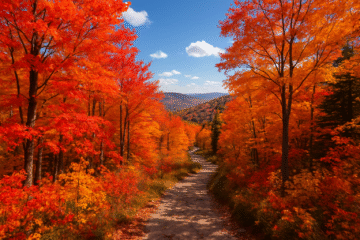
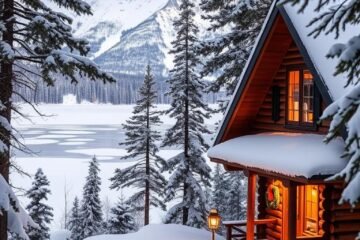
0 Comments